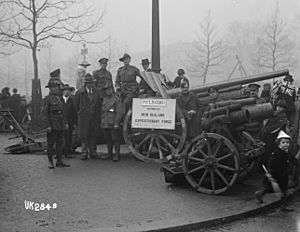Field gun facts for kids
A field gun is a type of artillery weapon. Artillery means large guns that fire shells over long distances. Field guns were first used to describe smaller cannons that an army could easily move while marching. During a battle, these guns could be quickly moved around the battlefield to where they were most needed.
Older, larger guns, like those in forts or siege cannon, were too big to move quickly. They were only used for long sieges, which are military blockades of a city or fort.
Napoleon was famous for using field guns with very large wheels. This design allowed his army to move them quickly, even in the middle of a battle. By moving these guns to different spots, they could break up groups of enemy soldiers. This helped his infantry (foot soldiers) fight more effectively.
Contents
Field Guns in World War I
As artillery technology improved, almost all guns, no matter their size, could be moved faster. By the start of World War I, even the biggest siege weapons could be moved by road or train.
During this time, the focus shifted to making smaller weapons even more mobile. Even the very heavy guns used by Germany in World War II could be moved by rail or special tracked vehicles.
In the British army, a "field gun" was any gun up to about 4.5 inches (114 mm) in size. Larger guns were called "medium," and the biggest ones were "heavy." For example, their largest field gun, the 5.5 inch (140 mm) Medium, could fire a shell about 15,000 to 16,000 yards (about 14.5 kilometers).
Field Guns in World War II
After World War II began, the term "field gun" was used for long-range artillery that fired shells at a fairly flat angle. This was different from howitzers, which could fire shells at much higher angles.
By the end of World War II, most artillery used were howitzers, usually between 105 mm and 155 mm in size. Only a few common field guns were still in use. These included the British 5.5 inch gun and the US 155 mm Long Tom. The Long Tom was actually an improved version of a French weapon from World War I.
Field Guns in the 1960s
The US Army brought back long-range guns in the 1960s with the M107 175 mm gun. This gun was used in the Vietnam War. It was very good at fighting other artillery.
However, the M107 needed a lot of repairs. Its barrels also started to crack, so it was eventually taken out of service by the US Army. Even so, the M107 continued to be made until the 1980s. It is still used by the Israeli military today.
Modern Artillery Today
Today, the traditional field gun is not used much anymore. Smaller, highly mobile artillery roles are now filled by the mortar. Mortars are light enough to be carried by soldiers. They have replaced almost all artillery pieces smaller than 105 mm.
Gun-howitzers are now used for the middle ground. These are usually 155 mm guns (used by NATO countries) or 152 mm guns (from the former USSR).
For very long-range attacks, armies now use rocket artillery or aircraft. Modern gun-artillery, like the L118 105mm light gun, provides fire support for infantry and tanks. They are used at ranges where mortars are not powerful enough.
Some weapons, like the rifled towed mortar, combine features of both. These 120mm mortars are light enough to be pulled by a Land Rover. They can fire a bomb over 6,000 meters, with the power of an artillery shell.
Related pages
Images for kids
See also
 In Spanish: Cañón de campaña para niños
In Spanish: Cañón de campaña para niños



